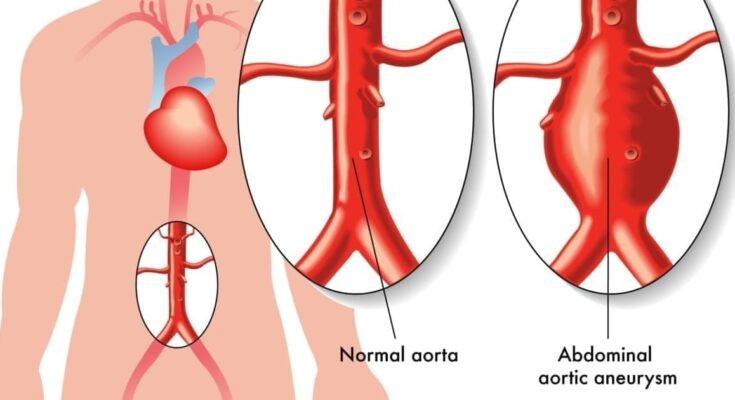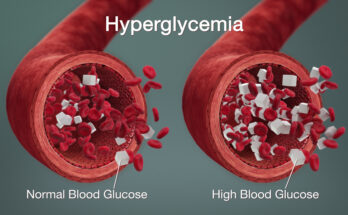Abdominal Aortic Aneurysm Symptoms: An abdominal aortic aneurysm (AAA) is a concerning medical condition characterized by a ballooning or enlargement of the aorta, the primary artery that runs through the abdomen.
This condition can remain silent for years, making it imperative to recognize the symptoms. When undiagnosed or left untreated, an AAA can rupture, leading to life-threatening complications.
Thus, understanding the signs and symptoms of an abdominal aortic aneurysm is crucial for timely diagnosis, ensuring immediate medical intervention and reducing potential risks.
By arming ourselves with this knowledge, we can prioritize our health and take prompt action when necessary.
What is an Abdominal Aortic Aneurysm?
An Abdominal Aortic Aneurysm (AAA) is a medical term that might sound complex, but we’re here to break it down for you.
Definition and Explanation of AAA:
An Abdominal Aortic Aneurysm refers to the enlargement or ballooning of a part of the aorta that passes through the abdomen. This enlargement can pose a risk, as it might rupture, leading to life-threatening internal bleeding. Essentially, the aortic wall becomes weakened in a specific section, causing it to expand. Over time, if not monitored or treated, this can become a significant health concern.
The Anatomy of the Aorta and Where the Aneurysm Occurs:
The aorta is the primary artery in the body, responsible for supplying oxygenated blood from the heart to the rest of the body. This large, tube-shaped artery runs from the heart through the chest and down into the abdomen. Within the abdomen, the aorta delivers blood to the lower parts of the body. It’s in this abdominal section that an AAA typically forms. Think of the aorta as a major highway for blood, and the AAA as a bulge or weak point on that highway.
To ensure you maintain optimal health, it’s essential to recognize the signs and risks associated with an AAA and to consult with a healthcare professional if you believe you might be at risk.
By understanding terms like Abdominal Aortic Aneurysm and the anatomy involved, you’re taking a proactive step towards better heart and vascular health.
The Prevalence and Importance of Recognizing Abdominal Aortic Aneurysm
Statistics Related to AAA
Abdominal Aortic Aneurysm (AAA) is more common than many might think, underlining the need for awareness and early detection:
- Prevalence: Studies estimate that AAA affects between 1% and 2% of the population over 65 years of age.
- Gender Variance: Men are at a higher risk, with prevalence rates being up to 6 times higher than in women.
- Mortality Rate: Fatal ruptures of AAAs account for about 1.3% of deaths in men aged 65-85 in developed countries.
Potential Consequences of an Untreated Aneurysm
The repercussions of neglecting an AAA can be dire:
- Rupture Risk: The most catastrophic consequence of an untreated AAA is a rupture. The risk of rupture increases with the size of the aneurysm.
- Life-threatening Hemorrhage: When an AAA ruptures, it can lead to internal bleeding, which is often life-threatening. Prompt surgical intervention is crucial.
- Organ Impact: A growing aneurysm can press against other organs, causing pain and potential damage.
- Embolization: Small blood clots can form in the aneurysm. These clots can be carried away with the blood flow, leading to blockages in other parts of the body, which can be harmful.
However, early recognition and appropriate management of an Abdominal Aortic Aneurysm can be life-saving. Regular screenings, especially for high-risk groups, play a pivotal role in mitigating the potential fatal consequences of this condition.
Abdominal Aortic Aneurysm Symptoms
Understanding the symptoms of an abdominal aortic aneurysm is crucial for early detection and treatment. The signs can range from mild and subtle to sudden and severe, depending on the stage and condition of the aneurysm. Here’s a breakdown:
A. Early and Subtle Symptoms
1. Mild Pain or Discomfort: Initially, you might experience a gentle pain or unease in the abdominal area or at the back.
2. Pulsing Sensation: Some individuals report feeling a rhythmic throbbing close to the belly button.
B. Symptoms of a Growing Aneurysm
1. Increasing Pain: As the aneurysm enlarges, the pain in the abdomen or back tends to become more pronounced.
2. Constant, Deep Pain: A persistent, profound discomfort can be an indicator of an expanding aneurysm.
C. Symptoms of a Ruptured Aneurysm
1. Sudden and Intense Pain: A ruptured aneurysm can lead to abrupt, sharp pain in the abdominal or back region.
2. Radiating Pain: This pain might extend, radiating down to the pelvis or even the legs.
3. Physical Symptoms: Other alarming signs include clammy skin, feelings of dizziness, and nausea.
It’s vital to stress that if you or someone you know exhibits symptoms of a ruptured aneurysm, seeking immediate medical attention is essential. Prompt care can significantly influence outcomes and potentially save a life.
Causes of Abdominal Aortic Aneurysm
A. Atherosclerosis
Atherosclerosis, commonly known as the hardening of the arteries, occurs when there’s a buildup of plaque in the blood vessels. This accumulation can cause the walls of the aorta to weaken, increasing the risk of an abdominal aortic aneurysm (AAA). Maintaining cardiovascular health can minimize this risk.
B. Tobacco use
There’s a direct correlation between tobacco use, particularly smoking, and the development of AAA. Smoking introduces harmful chemicals into the body, causing damage to the aortic wall. Over time, this weakens the aorta and can lead to an aneurysm. Reducing or quitting smoking is crucial for prevention.
C. High blood pressure
Hypertension, or high blood pressure, puts added stress on the walls of the aorta. This extra pressure can weaken the aortic wall, making it more susceptible to an aneurysm. Monitoring and managing blood pressure is essential to reduce the risk of AAA.
D. Infection
Certain infections can lead to inflammation of the aortic wall. This inflammation can compromise the structural integrity of the aorta and increase the risk of an aneurysm. Staying proactive with health check-ups can help identify and treat such infections early.
E. Genetic factors
Family history plays a significant role in the risk of developing an AAA. Individuals with a close family member who had an AAA are at a higher risk. Understanding one’s family medical history and undergoing regular screenings can be beneficial for those with a genetic predisposition.
However, several factors can lead to the development of an abdominal aortic aneurysm. By understanding and managing these causes, one can take proactive measures to reduce the risk.
Risk Factors of Abdominal Aortic Aneurysm
Understanding the risk factors associated with AAA can aid in early detection and intervention. Here are the primary risk factors to be aware of:
1. Gender, Age, and Family History:
Men are at a higher risk of developing AAA compared to women. Advancing age, especially being over 60, also increases the chances of an AAA. Additionally, a family history of abdominal aortic aneurysms significantly elevates one’s risk, underscoring the importance of communicating with family members about their health history.
2. Lifestyle Choices:
- Smoking: One of the most substantial risk factors for AAA is smoking. Those who smoke or have smoked in the past are at a heightened risk compared to non-smokers. Reducing or quitting tobacco use can substantially decrease this risk.
- Diet: Consuming a diet high in fat and cholesterol can contribute to atherosclerosis, a condition where the arteries harden. This, in turn, can increase the risk of AAA. Maintaining a balanced diet, rich in fruits, vegetables, and whole grains, can play a pivotal role in preventing AAA.
3. Other Medical Conditions:
Certain medical conditions can elevate the risk of developing an AAA. This includes conditions like high blood pressure, coronary artery disease, and a history of vascular diseases. Regular check-ups and managing these conditions can significantly reduce the risk.
Awareness of these risk factors can guide individuals in making informed decisions about their health, leading to early detection and optimal management of AAA.
Conclusion
In wrapping up, recognizing the symptoms of an abdominal aortic aneurysm (AAA) is paramount. Not only does early identification safeguard an individual’s health, but it can also be life-saving.
The consequences of missing or delaying a diagnosis can be dire, underscoring the undeniable significance of staying informed and vigilant.
Furthermore, the sooner an AAA is detected, the better the chances of successful intervention and treatment. Timely diagnosis can prevent complications and provide the best possible outcomes for patients.
Prioritizing early detection and intervention, therefore, should be at the forefront of our healthcare objectives. Remember, knowledge is power, and in this context, it might just save a life.


